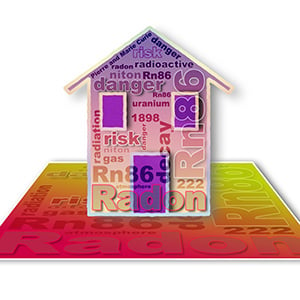The EPA has designated January as Radon Action Month to help people understand the risks of radon in buildings. Radon is a health hazard, but, there is a simple solution to make sure you and your family are protected.
 Radon can be a scary thing to think about in your home but testing for radon is easy. And, if needed, radon mitigation can be done quickly and often without any disruptions to your daily routine. There are many qualified contractors locally who do this work and they are easy to find.
Radon can be a scary thing to think about in your home but testing for radon is easy. And, if needed, radon mitigation can be done quickly and often without any disruptions to your daily routine. There are many qualified contractors locally who do this work and they are easy to find.
First, let’s discuss what radon is and where it comes from.
Radon is an odorless gas that is released from naturally decaying radium and uranium in the soil. Radium is radioactive and was discovered in 1898 by Marie and Pierre Curie in a “pitchblende” (a mineral ore of uranium containing 50-80% of the uranium element). Pitchblende deposits, containing both uranium and radium minerals, are also known to be found in Colorado. Uranium has been used to create nuclear-fission in atomic weapons and has been used as a source of nuclear energy for over 60 years. To connect this all back to radon, it’s important to understand that radium is found in nature as a result of its continuous formation from uranium decay. Radium occurs in all uranium ores and Radon gas forms from the decay of these radioactive elements.
The American Cancer Society states on their website that radon is present both outdoors and indoors, but usually at higher levels inside buildings. They share that radon attaches to dust and other particles and can be breathed into the lungs. And, radon gets into buildings “through cracks in floors or walls; construction joints; or gaps in foundations around pipes, wires, or pumps.” This means radon gas levels are usually highest in the levels closest to the soil or rock, mainly the basement or crawl space.
The Colorado Department of Public Health and Environment (CDPHE) states that “radon has no color, odor or taste and doesn't cause short-term symptoms of illness.” And, radon does cause cancer. Radon gas exposure is the 2nd leading cause of lung cancer in the US, according to the surgeon general. That is about 21,000 lung cancer deaths per year. Only smoking causes more lung cancer deaths. More specifically, radon is prevalent in Colorado, as our soils are uranium rich. The CDPHE points out that radon has been found in all 50 states, and “in Colorado, about half the homes have radon levels higher than the U.S. Environmental Protection Agency recommended action level of 4 picoCuries per liter (pCi/L).”
Are you ready to find out the levels of radon in your home? This is easy. And, a good way to start is a short-term self-administered kit that you mail-in. All year long there are FREE radon test kits available at Walking Mountains Science Center in Avon for homeowners and renters in the local Eagle County area to pick up. These are simple kits that you open and leave out for about 3 days, and it is recommended that you keep all windows shut during the test time, and place the kit in the most occupied space on the lowest living level of your home. Then you mail it in and the results are sent to you via email. You can also have a professional test your home, most Real Estate Inspectors offer this service.
If you are interested in learning more about radon & Real Estate, the EPA has a page of great resources for Home Buyers and Sellers here. It includes more information about buying a new home, building a home, creating radon-resistant new construction, a full guide to radon, how to fix your home, and a guide for tenants.
RADIO QUICK FACTS & ACTIONS FOR HOME SAFETY
• Radon is odorless, colorless, flavorless, and radioactive.
• Radon naturally occurs in Colorado from decaying uranium & radium in our soils.
• Radon is the second leading cause of lung cancer (smoking is the first).
• The EPA recommends radon levels in your home be less than 4 picoCuries per liter (pCi/L).
• Testing your home for radon is easy - use a professional, or pick-up a FREE short-term test kit from Walking Mountains Science Center in Avon that you can mail-in yourself.
• Complete radon mitigation work on your home if your levels are above 4 pCi/L - find qualified professionals at certifiedradonpros.org/co.html.
• Increase airflow in your home, consider mechanical ventilation - home mechanical HVAC professionals can help with this.
By Nikki Maline, Energy Programs Director at Walking Mountains Science Center







